Bataan Death March
| Bataan Death March | |||||
|---|---|---|---|---|---|
| Part of the Battle of Bataan, World War II | |||||
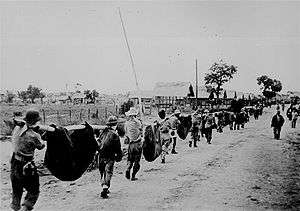 A burial detail of Filipino and prisoners of war uses improvised litters to carry fallen comrades at Camp O'Donnell, Capas, Tarlac, 1942, following the Bataan Death March. | |||||
| |||||
| Casualties and losses | |||||
|
| |||||
The Bataan Death March (Filipino: Martsa ng Kamatayan sa Bataan; Japanese: バターン死の行進, Hepburn: Batān Shi no Kōshin) was the forcible transfer by the Imperial Japanese Army of 60,000–80,000 Filipino and American prisoners of war from Saisaih Point and Mariveles to Camp O'Donnell, Capas, Tarlac, via San Fernando, Pampanga, where the prisoners were loaded onto trains. The transfer began on April 9, 1942, after the three-month Battle of Bataan in the Philippines during World War II.[1][2] About 2,500–10,000 Filipino and 100–650 American prisoners of war died on the march before they reached their destination.[3][4][5] The reported death tolls vary, especially among Filipino POWs, because historians cannot determine how many prisoners blended in with the civilian population and escaped.
The 60 mi (97 km) march was characterized by severe physical abuse. It was later judged by an Allied military commission to be a Japanese war crime.[2]
The march
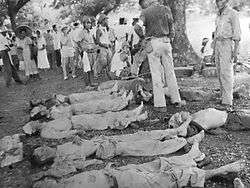
Following the surrender of Bataan on April 9, 1942 to the Japanese Imperial Army, prisoners were massed in in Mariveles and Bagac town and ordered to march to Balanga City, the capital of Bataan. Some were beaten, bayoneted, and otherwise mistreated. The first atrocity occurred when approximately 350 to 400 Filipino officers and NCOs were summarily executed near the Pantingan river after they had surrendered.[4][8] A recent historian[9] has dismissed the Pantingan massacre, (in acceptance of General Homma's defense counsel's argument that no bodies were ever found); however, the bodies were disinterred in mid-1946, after the conclusion of Homma's trial. This massacre has been attributed to Japanese army officer, Masanobu Tsuji, who acted against General Homma's wish that the prisoners be transferred peacefully. Tsuji intended to kill many of the prisoners, and he gave orders to this end.[10]
POWs received little food or water, and many died along the march.[3][11] Some POWs drank water from water buffalo wallows on the side of the road. Other POWs, however, were allowed water and several hundred rode to Camp O'Donnell in trucks.[12][13] Once the surviving prisoners arrived in Balanga, the overcrowded conditions and poor hygiene caused dysentery and other diseases to spread rapidly. The Japanese did not provide the prisoners with medical care, so U.S. medical personnel tended to the sick and wounded (with few or no supplies).[3] Of the estimated 80,000 POWs at the march, only 54,000 made it to Camp O'Donnell.
In a 2001 commemorative speech to the United States House of Representatives, Representative Dana Rohrabacher stated:
They were beaten, and they were starved as they marched. Those who fell were bayoneted. Some of those who fell were beheaded by Japanese officers who were practicing with their samurai swords from horseback. The Japanese culture at that time reflected the view that any warrior who surrendered had no honor; thus was not to be treated like a human being. Thus they were not committing crimes against human beings.[...] The Japanese soldiers at that time [...] felt they were dealing with subhumans and animals.[14]
Trucks drove over some of those who fell or succumbed to fatigue,[15][16][17] and "cleanup crews" put to death those too weak to continue, though some trucks picked up some of those too fatigued to continue. Some marchers were randomly stabbed by bayonets or beaten.[18][19]
From San Fernando, the prisoners were transported by rail to Capas. At least 100 prisoners were pushed into each of the trains' unventilated boxcars, which were sweltering in the tropical heat. The trains had no sanitation facilities, and disease continued to take a heavy toll on the prisoners. After they reached Capas, they were forced to walk the final 9 miles to Camp O'Donnell.[3] Even after arriving at Camp O'Donnell, the survivors of the march continued to die at rates of up to several hundred per day, which amounted to a death toll of as many as 12,330 Filipino and American deaths.[13][20] Most of the dead were buried in mass graves that the Japanese had dug behind the barbed wire surrounding the compound.[21]
Wartime public responses
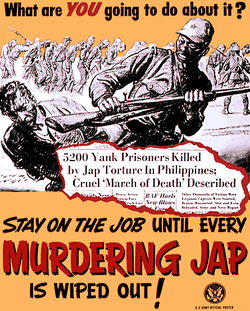
United States
It was not until January 27, 1944, that the U.S. government informed the American public about the march, when it released sworn statements of military officers who had escaped.[22] Shortly thereafter the stories of these officers were featured in a LIFE magazine article.[23][24] The Bataan Death March and other Japanese actions were used to arouse fury in the United States.[25]
General George Marshall made the following statement:
These brutal reprisals upon helpless victims evidence the shallow advance from savagery which the Japanese people have made. [...] We serve notice upon the Japanese military and political leaders as well as the Japanese people that the future of the Japanese race itself, depends entirely and irrevocably upon their capacity to progress beyond their aboriginal barbaric instincts.[26]
Japanese
In an attempt to counter the American propaganda value of the march, the Japanese had The Manila Times report that the prisoners were treated humanely and their death rate had to be attributed to the intransigence of the American commanders who did not surrender until the men were on the verge of death.[27]
War crimes trial
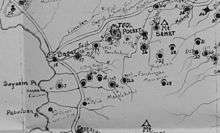
In December 1943, (General) Masaharu Homma was selected as the minister of information for the incoming prime minister, Kuniaki Koiso. In September 1945, he was arrested by Allied troops and indicted for war crimes.[28] Homma was charged with 43 different counts of crimes against humanity.[29] The court found that Homma had permitted his troops to commit "brutal atrocities and other high crimes".[30] The general, who had been absorbed in his efforts to capture Corregidor after the fall of Bataan, claimed in his defense that he remained ignorant of the high death toll of the death march until two months after the event.[31] On February 26, 1946, he was sentenced to death by firing squad. He was executed on April 3, 1946, outside Manila.[28]
Also in Japan, Generals Hideki Tōjō (later Prime Minister), Kenji Doihara, Seishirō Itagaki, Heitarō Kimura, Iwane Matsui, and Akira Mutō, along with Baron Kōki Hirota, were found guilty and responsible for the maltreatment of American and Filipino POWs. They were executed by hanging at Sugamo Prison in Ikebukuro on December 23, 1948. Several others were sentenced to imprisonment between 7 and 22 years.
Post-war commemorations, apologies, and memorials

In 2012, film producer Jan Thompson created a film documentary about the Death March, POW camps, and Japanese hell ships titled Never the Same: The Prisoner-of-War Experience. The film reproduced scenes of the camps and ships showed drawings and writings of the prisoners, and featured Loretta Swit as the narrator.[32][33]
On September 13, 2010, Japanese Foreign Minister Katsuya Okada apologized to a group of six former American soldiers who, during World War II were held as prisoners of war by the Japanese, including 90-year-old Lester Tenney and Robert Rosendahl, both survivors of the Bataan Death March. The six, their families, and the families of two deceased soldiers were invited to visit Japan at the expense of the Japanese government.[34]
Dozens of memorials (including monuments, plaques, and schools) dedicated to the prisoners who died during the Bataan Death March exist across the United States and in the Philippines. A wide variety of commemorative events are held to honor the victims, including holidays, athletic events such as ultramarathons, and memorial ceremonies held at military cemeteries.
The Bataan Death March had a large impact on the U.S. state of New Mexico,[35] given that many of the U.S. soldiers in Bataan were from New Mexico, specifically from the 200th/515th Coast Artillery of the National Guard.[36] The New Mexico National Guard Bataan Memorial Museum is located in the Armory where the soldiers of the 200th and 515th were processed before their deployment to the Philippines in 1941.[37] Every year, in early spring, the Bataan Memorial Death March, a 26.2-mile march/run is conducted at White Sands Missile Range, New Mexico.[38][39] As of 2012, there were fewer than 1,000 survivors of the March still living.[40] The old state capitol building of New Mexico was renamed the Bataan Memorial Building and now houses several state government agency offices.[41]
Notable survivors and captives
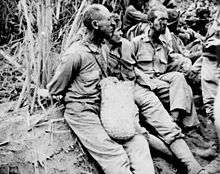
- José Agdamag
- Ramon Bagatsing
- Bert Bank
- Albert Braun
- Thomas F. Breslin
- Albert Brown
- Jose Calugas
- Virgilio N. Cordero, Jr.
- William Dyess
- Alva R. Fitch
- Martin Gison
- Samuel A. Goldblith
- Samuel Grashio
- Samuel L. Howard
- Ray C. Hunt
- Harold Keith Johnson
- Joe Kieyoomia
- Edward P. King
- Jesse Monroe Knowles
- Charles S. Lawrence
- Joe Lingad
- John E. Olson
- Salvador A. Rodolfo, Sr.
- Robert Sheats
- Austin Shofner[43]
- Wilburn Snyder
- James C. Spencer
- Benigno G. Tabora
- Robert P. Taylor
- Mario Tonelli
- Thomas J. H. Trapnell
- Edgar Whitcomb
- Manuel T. Yan
- Teófilo Yldefonso
See also
References
Notes
- ↑ "Bataan Death March. Britannica Encyclopedia Online". Britannica.com. 1942-04-09. Retrieved 2012-12-17.
- 1 2 Falk, Stanley L. (1962). Bataan: The March of Death. New York: W. W. Norton & Company. OCLC 1084550.
- 1 2 3 4 Lansford, Tom (2001). "Bataan Death March". In Sandler, Stanley. World War II in the Pacific: an encyclopedia. Taylor & Francis. pp. 159–60. ISBN 978-0-8153-1883-5.
- 1 2 Norman, Michael & Norman, Elizabeth. Tears in the Darkness (revised ed.). Farrar, Straus and Giroux. ISBN 978-0374272609.
- ↑ Seven Czech prisoners were among the captives. Philippine Star, "Czech Heroes in Bataan"
- ↑ Hubbard, Preston John (1990). Apocalypse Undone: My Survival of Japanese Imprisonment During World War II. Vanderbilt University Press. p. 87. ISBN 978-0-8265-1401-1.
- ↑ Bilek, Anton (Tony) (2003). No Uncle Sam: The Forgotten of Bataan. Kent State University Press. p. 51. ISBN 0-87338-768-6.
- ↑ Lansford, Tom (2001). "Bataan Death March". In Sandler, Stanley. World War II in the Pacific: an encyclopedia. Taylor & Francis. pp. 157–158. ISBN 978-0-8153-1883-5.
- ↑ Murphy, Kevin C. Inside the Bataan Death March Defeat, Travail (Jefferson, NC: McFarland, 2014), 226-27 9780786496815.
- ↑ "The Causes of the Bataan Death March Revisited".
- ↑ Murphy, Kevin C. Inside the Bataan Death March: Defeat, Travail (Jefferson, NC: McFarland, 2014), 156–58.
- ↑ Murphy, Kevin C. Inside the Bataan Death March: Defeat, Travail (Jefferson, NC: McFarland, 2014), 240-67.
- 1 2 Olson, John E. (1985). O'Donell: Andersonville of the Pacific. John E. Olson. ISBN 978-9996986208.
- ↑ U.S. Congressional Representative Rohrabacher, "Paying Homage to a Special Group of Veterans, Survivors of Bataan and Corregidor", Congressional Record – House, V. 147, Pt. 9, June 26, 2001, p. 11981
- ↑ Greenberger, Robert (2009). The Bataan Death March: World War II Prisoners in the Pacific. p. 40.
- ↑ Doyle, Robert C. (2010). The enemy in our hands: America's treatment of enemy prisoners of war from the Revolution to the War on Terror. University Press of Kentucky. p. xii. ISBN 978-0-8131-2589-3.
- ↑ Hoyt, Eugene P. (2004). Bataan: a survivor's story. University of Oklahoma Press. p. 125. ISBN 978-0-8061-3582-3.
- ↑
- Stewart, Sidney. Give Us This Day (revised ed.). W. W. Norton & Company. ISBN 0-393-31921-0.
- ↑ Murphy, Kevin C. Inside the Bataan Death March: Defeat, Travail (Jefferson, NC: McFarland, 2014). pp. 240–66.
- ↑ O'Donnell Provost Marshal Report
- ↑ Downs, William David (2004). The Fighting Tigers: the untold stories behind the names on the Ouachita Baptist University WWII memorial. University of Arkansas Press. pp. 106–7. ISBN 978-0-9713470-5-2.
- ↑ Friedland, Roger & Mohr, John (2004). Matters of culture: cultural sociology in practice. Cambridge University Press. p. 197. ISBN 978-0-521-79545-6.
- ↑ McCoy, Melvin; Mellnik, S.M.; Kelley, Welbourn (February 7, 1944). "Prisoners of Japan: Ten Americans Who Escaped Recently from the Philippines Report on the Atrocities Committed by the Japanese in Their Prisoner-War-Camps". LIFE. Chicago: Time, Inc. 16 (6): 26–31, 96–98, 105–106, 108, 111.
- ↑ Life Magazine February 7, 1944
- ↑ Jansen, Marius B. (2000). The Making of Modern Japan. p. 655.
- ↑ Chappell, John David (1997). Before the bomb: how America approached the end of the Pacific War. University of Kentucky Press. p. 30. ISBN 978-0-8131-1987-8.
- ↑ Toland, John (1970). The Rising Sun: The Decline and Fall of the Japanese Empire 1936–1945. New York: Random House. p. 300.
- 1 2 Sandler, Stanley, ed. (2001). "Homma Masaharu (1887–1946)". World War II in the Pacific: an encyclopedia. Taylor & Francis. p. 420. ISBN 978-0-8153-1883-5.
- ↑ Maga, Timothy P. (2001). Judgment at Tokyo: the Japanese war crimes trials. University Press of Kentucky. p. 21. ISBN 978-0-8131-2177-2.
- ↑ Solis, Gary D. (2010). The law of armed conflict: international humanitarian law in war. Cambridge University Press. p. 384. ISBN 978-0-521-87088-7.
- ↑ "The Trial Of General Homma".
- ↑ Brotman, Barbara (April 1, 2013). "From Death March to Hell Ships". Chicago Tribune. pp. Lifestyles.
- ↑ Among others, additional narration was provided by Ed Asner, Alec Baldwin, Kathleen Turner, and Robert Wagner. "Never the Same: The Prisoner of War Experience". Gene Siskal Film Center. School of the Art Institute of Chicago.
- ↑ "Japanese/American POW Friendship Program". www.us-japandialogueonpows.org. 2010.
- ↑ Lauren E. Toney (24 March 2012). "Bataan survivors attend rededication of monument Saturday". Las Cruces Sun-News. Archived from the original on 14 March 2013. Retrieved 22 February 2013.
- ↑ "Timeline". Battle for Bataan!. New Mexico State University. Retrieved 23 February 2013.
- ↑ Phillips, R. Cody (2005). The Guide to U.S. Army Museums. Government Printing Office. p. 82. ISBN 9780160872822. Retrieved 23 February 2013.
- ↑ "USA Marathons & Marathoners 2007". marathonguide.com. Retrieved May 8, 2008.
- ↑ Schurtz, Christopher (March 22, 2010). "Record Number Gather To Honor Bataan Death March". Las Cruces Sun-News. p. 1.
- ↑ Bataan Museum
- ↑
- ↑ From work of Jason MacDonald
- ↑ Shofner was an American officer, captured on Corregidor, who escaped DaPeCol in 1943.
Further reading
- Abraham, Abie (1997). "Oh God Where Are You?". Vantage Press. ISBN 978-0533119875
- Abraham, Abie (2001). Ghost of Bataan Speaks. Beaver Pond. ASIN B004L73AXC
- Falk, Stanley L. (1962). Bataan: The March of Death. New York: W. W. Norton & Company. OCLC 1084550.
- Harrison, Thomas R. (1989). Survivor: Memoir of Defeat and Captivity – Bataan, 1942. Western Epics, Inc., Salt Lake City, Utah. ISBN 0916095290.
- Jackson, Charles; Norton, Bruce H. (2003). I Am Alive!: A United States Marine's Story of Survival in a World War II Japanese POW Camp. Presidio Press. ISBN 0345449118.
- Jansen, Marius B (2000). The Making of Modern Japan. Cambridge, MA: Harvard University Press. pp. 654–655. ISBN 978-0674003347. OCLC 44090600.
- Levering, Robert (1948). Horror trek; a true story of Bataan, the death march and three and one-half years in Japanese prison camps. Horstman Printing. ISBN 1258206307. OCLC 1168285.
- Lukacs, John D. (2010). Escape from Davao. New York: Simon & Schuster. ISBN 978-0743262781. OCLC 464593097.
- Machi, Mario (1994). Under the Rising Sun, Memories of a Japanese Prisoner of War. Wolfenden, USA. ISBN 0964252104.
- Masuda, Hiroshi (2012). MacArthur in Asia: The General and His Staff in the Philippines, Japan, and Korea. Ithaca, NY: Cornell University Press. ISBN 978-0801449390.
- Moody, Samuel B.; Allen, Maury (1961). Reprieve from Hell. New York: Pageant Press. OCLC 14924946.
- Morrow, Don; Moore, Kevin (2011). Forsaken Heroes of the Pacific War: One Man's True Story. Roanoke, VA: Wounded Warrior Project. ISBN 978-1565924796. OCLC 725827438.
- Murphy, Kevin C. (2012). "'Raw Individualists': American Soldiers on the Bataan Death March Reconsidered". War & Society. 31: 42–63. doi:10.1179/204243411X13201386799172.
- Murphy, Kevin C. (October 13, 2014). Inside the Bataan Death March: Defeat, Travail and Memory. McFarland. ISBN 978-0786496815.
- Olson, John E. (1985). O'Donell: Andersonville of the Pacific. John E. Olson. ISBN 978-9996986208.
- Norman, Michael & Norman, Elizabeth. Tears in the Darkness (revised ed.). Farrar, Straus and Giroux. ISBN 978-0374272609.
- Also see: Webcast interview with the authors at the Pritzker Military Library on September 24, 2009
- Resa, Jolinda Bull (2011). Honor Them Always: For the Sacrifice of Their Youth at Bataan. Outskirts Press, Inc. ISBN 978-1432775551. OCLC 782073328.
- Sides, Hampton (2001). Ghost Soldiers. New York: Anchor Books. ISBN 978-1299076518. OCLC 842990576.
- Stephens, Harold (October 16, 1994). "Memories of the War". Humboldt Co., CA.: "Times-Standard," Sect. Style/potpourri.
- Stewart, Sidney. Give Us This Day (revised ed.). W. W. Norton & Company. ISBN 0393319210.
- Tenney, Lester (2000). My Hitch in Hell. Brassey's. ISBN 978-1574882988. OCLC 557622115.
- Young, Donald J. (1992). The Battle of Bataan: A History of the 90 Day Siege and Eventual Surrender of 75,000 Filipino and United States Troops to the Japanese in World War. McFarland. ISBN 0899507573.
External links
| Wikimedia Commons has media related to Bataan Death March. |
- Tragedy of Bataan
- No Uncle Sam: The Forgotten of Bataan – A link to the book's page on the publisher's website
- Hell's Guest author Colonel Glenn Frazier, Bataan Death March Survivor
- "Back to Bataan, A Survivor's Story" – A narrative recounting one soldier's journey through Bataan, the march, prison camp, Japan, and back home to the United States. Includes a map of the march.
- The Bataan Death March – Information, maps, and pictures on the march itself and in-depth information on Japanese POW camps.
- "Technical Sergeant Jim Brown U.S. Army Air Corps (ret) Bataan Death March Survivor Presentation to EAA Chapter 108 May 16, 2000"
- Proviso East High School Bataan Commemorative Research Project – Comprehensive history of the Battle for Bataan, the Death March and the role of the 192nd Tank Battalion
- 4th Marines at Corregidor and Bataan Death March
- 1200 Days, A Bataan POW Survivor's Story A biography of Russell A. Grokett's survival of the Bataan Death March, including three years as a Japanese Prisoner of War.
- Japan Focus 2008
- Bataan Death March and POW Camps and Bataan Survivors Recall Horrors, Borderlands articles
